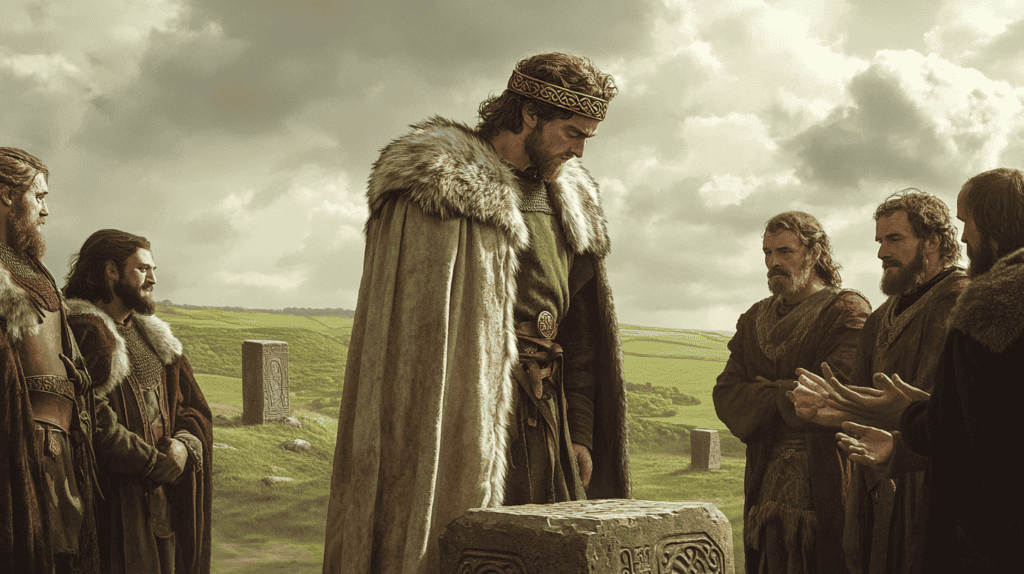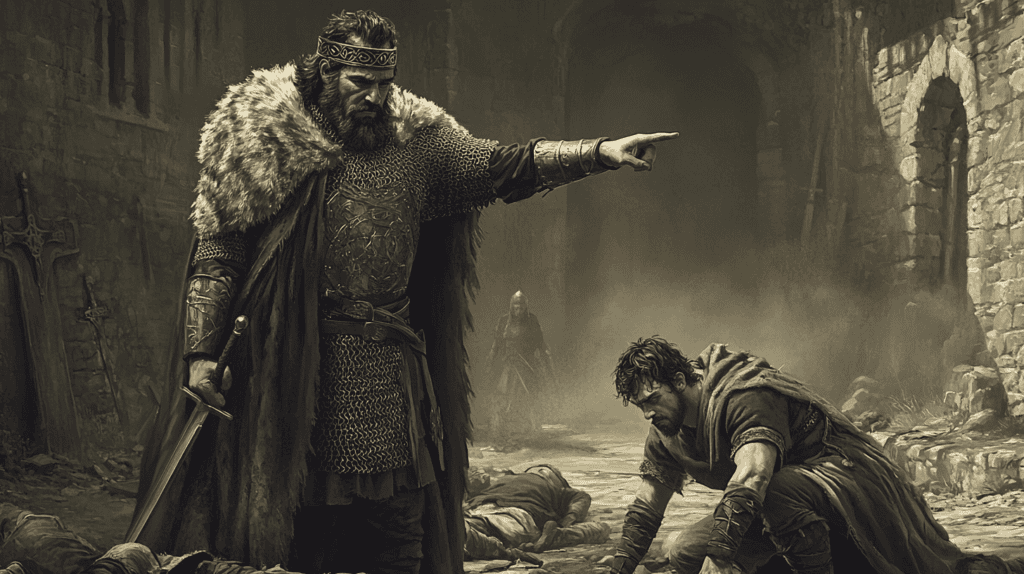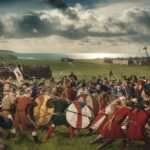
The rise and reign of Flann Sinna, High King of Ireland from 879 to 916 CE, is a tale of ambition, political maneuvering, and brutal warfare that shaped the landscape of Ireland. Born around 848 CE, Flann was the son of Mael Sechnaill mac Maele Ruanaid, a ruthless king who had paved his own path to power through assassination and conquest.
The Path to Power
Flann’s ascent to the throne was marked by calculated alliances and strategic marriages. In 870 CE, he wed Gormlaith, daughter of the King of Brega, securing a foothold in a kingdom that held the sacred Hill of Tara. But Flann’s ambitions reached further. Breaking with tradition that alternated the high kingship between northern and southern Uí Néill branches, he divorced Gormlaith and married Eithne, daughter of the reigning High King Aed Findliath.
With this new connection to the royal house, Flann eliminated his rival, his second cousin Donnchad, through assassination. When Aed Findliath died in 879 CE, Flann’s machinations bore fruit as he was crowned High King at Tara.

Consolidation of Power
Flann’s reign began with a display of ruthless pragmatism. He swiftly divorced Eithne and married his own stepmother, Mael Muire, daughter of Kenneth MacAlpin, King of the Scots. This shocking move cemented his claim to the throne and expanded his influence beyond Ireland’s shores.
To assert his authority, Flann demanded hostages from other kingdoms, a common practice to ensure compliance. When met with resistance, he allied with Norse-Gaels and other Norse chiefs, launching an attack on Armagh. This show of force compelled the recalcitrant kingdoms to submit their hostages to Tara.

Battles and Alliances
For the next two decades, Flann employed a strategy of shifting alliances, supporting various kingdoms against others with the aid of his Norse allies from Dublin. This tactic allowed him to maintain a delicate balance of power while gradually extending his influence.
However, Flann’s reign was not without setbacks. In 887 CE, he suffered a significant defeat at the Battle of the Pilgrim against Sichfrith, viking King of Dublin. Despite this loss, Flann’s ability to raise an army from multiple Irish kingdoms to fight together against Sichfrith demonstrated the extent of his authority beyond his home territory of Mide.
Internal Strife
Even as Flann consolidated his power across Ireland, he faced challenges from within his own family. In 901 CE, his son Donnchad Donn rebelled. Flann responded with characteristic brutality, slaughtering his son’s associates at the abbey of Kells, though sparing Donnchad himself.

The Battle of Ballaghmoon
The defining moment of Flann’s reign came in 908 CE at the Battle of Ballaghmoon. The conflict arose when Cormac mac Cuilennain, the scholarly King of Munster, was pressured into war with the Kingdom of Leinster by his advisor Flaithbertach mac Inmainen.
Leinster’s king, Cerball mac Muirecain, was Flann’s son-in-law and called upon the High King for aid. Flann, recognizing Cormac’s reputation as a man of peace and learning, was reluctant to engage. Cormac himself was equally hesitant, especially after omens foretold his death in battle.
Despite these misgivings, the armies met at Ballaghmoon. The battle was a catastrophe for Munster. Cormac, thrown from his horse, died on the field with his neck broken. In a grim postscript to the conflict, a Leinster soldier decapitated Cormac’s corpse and presented the head to Flann. The High King, however, showed unexpected reverence, lamenting the death of such a learned man and condemning the desecration of his remains.
The battle resulted in over 6,000 Munster casualties, a devastating blow that solidified Flann’s position as the dominant force in Ireland.

Decline and Legacy
Despite his victory at Ballaghmoon, Flann’s later years were marked by continued unrest. The Kingdom of Breifne rebelled in 910 CE, followed by Flann’s former home, the Kingdom of Brega, in 913 CE. Flann’s response to these challenges was harsh, razing numerous communities and earning a reputation as a destroyer of churches.
Flann Sinna’s reign ended with his death in 916 CE. His legacy is complex, marked by political acumen, military prowess, and cultural patronage. He is remembered for his effective consolidation of power, his victory at Ballaghmoon, and his support of religious institutions, particularly the Abbey of Clonmacnoise.
Yet, Flann’s rule was also characterized by violence, betrayal, and the destruction of rival power centers. His reign exemplifies the turbulent nature of dark age Irish politics, where alliances shifted like sand and power was maintained through a delicate balance of force and diplomacy.
In the annals of Irish history, Flann Sinna stands as a figure who shaped the political landscape of his time, leaving an indelible mark on the evolution of the Irish high kingship and the complex web of relationships between the island’s many kingdoms.




